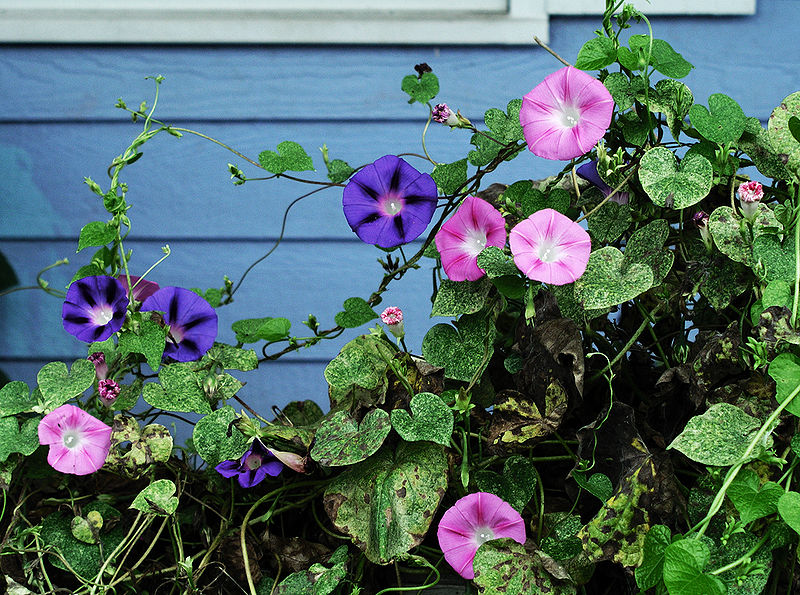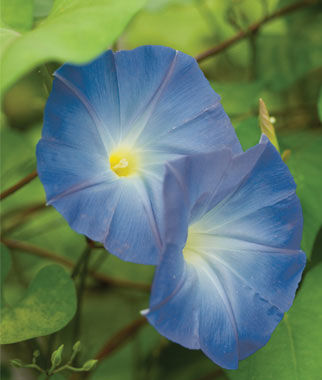
2024 Morning Glory Care Tips & Popular Types of Morning Glory (Sale+8% Cashback)
The image of the morning glory is represented in famous works of painting and sculpture across the world. It is also a regular reference in poetry, literature, and folklore. Walt Whitman says, “A morning-glory at my window satisfies me more than the metaphysics of books.” Morning glories are popular annual vines for growing up a fence, arbor, trellis or arch. There are also selections that grow well in containers on a deck or patio. Morning glories also self-sow readily so they will surprise you each year as new plants pop up in different parts of the garden. Since the vines grow and fill in so quickly, morning glories are popular for camouflaging ugly parts of the yard.
Morning Glory Plant Overview
An old favorite, morning glory is one of the easiest flowering vines to grow. Morning glory is the common name for over 1,000 species of flowering plants in the family Convolvulaceae, whose current taxonomy and systematics are in flux.
This plant is called morning glory for a reason: The flowers will close in the afternoon heat. Some people also refer to the plant as "back-to-school" vine, because it sometimes waits until the end of summer to start flowering. Flowers are white, blue, pink, purple, red, and multicolored. There are even double forms. Because they're quick, easy, and dependably colorful, morning glory is the most popular annual vine.
The morning glory has been used as a laxative in Asian and Mesoamerican countries for centuries, and tea was sometimes concocted from its roots as a diuretic and expectorant. Seeds from the morning glory have been consumed as a hallucinogenic substance because of a compound called LSA (similar to LSD). Mesoamerican Indians would imbibe these seeds to enter trances and altered states for ritualistic purposes. It's also considered a poisonous plant due to the toxic nature of those very same seeds; keep children away from it.

This vigorous vining plant (up to 15 feet) is often found covering country fences where their delicate flowers greet you with the morning sun. They are perfect for covering walls, privacy screens and lattice, so give these hardy annuals support and watch them grow. Since these climbing beauties are self-seeding, you'll probably get them coming back in the same spot year after year. Birds and bees love their large fragrant blossoms.
This tendency to spread and grow without borders, so much so that it is a known invasive species and illegal to plant in the state of Arizona, can be a problem for some gardeners. If you're planting some of these babies, make sure the plant doesn't invade your neighbor's yard or any wild spaces nearby!
Popular Varieties of Morning Glory
Heavenly Blue (Ipomoea tricolor)
Heavenly Blue (Ipomoea tricolor) is probably the most commonly grown variety of morning glory. With petals of vibrant, azure blue and centers of white and yellow, this flower is truly stunning. This native of Central and South America and Mexico is easy to start from seed. Because heavenly blue morning glory is frost tender it is frequently grown as an annual. In U.S. Department of Agriculture plant hardiness zones 10 and 11, however, this variety succeeds as a perennial. If you have an unattractive fence, this is a perfect way to cover it, and it also looks great in containers, as groundcovers, and in hanging baskets. Butterflies and hummingbirds love them, and they get up to 10 feet high, making them very noticeable. They are deer-resistant and look perfect in cottage gardens.

If you want to get one, don't forget to sign up at Extrabux (What is Extrabux?) , then you can enjoy up to 8% cashback from Extrabux! Sign-Up Bonus: Free to join it & get $20 welcome bonus!
Grandpa Ott (Ipomoea nil)
An heirloom flower from Bavaria, Germany, its heart-shaped leaves are emerald-green and it has flowers that are intense royal-purple and trumpet-shaped. The petals open in the morning and show off a ruby-red, star-shaped throat, which is quite stunning. Blooming continuously from early Summer to early Fall, the Grandpa Ott's flowers grow up to 3 inches wide on vines up to 10 feet tall. They are perfect along walls or fences, require no pruning, and hummingbirds and butterflies love them. They also self-seed very easily. They are also virtually pest- and disease-free.

Scarlett O'Hara (Heirloom)
Named after the heroine of the famous 'Gone With the Wind' , the morning glory variety called Scarlett O’Hara. Scarlet Star flowers are a brilliant cherry red with a distinctive white star shape in the center. It unfurls her true glory from mid-summer until frost in daily displays of brilliant, scarlet trumpets with dainty white throats that offer welcome nectar to visiting hummingbirds. The rich green leaves make a lovely backdrop for the radiant color of the 4" fluted blooms. Enjoy the charm of these old-fashioned bright beauties twining up a trellis or arbor.

Moonflower (Ipomoea alba)
A beautiful flower with a sweet scent and an attractive white color, the Moonflower has petals that open up in the evenings and close in the mornings when the sun touches them. They have a pale-green star in the center, which is highlighted once the petals are open. Their sweet fragrance is more noticeable when they're open as well, and the night air is saturated with its pleasantness. It blooms continuously from mid-Summer to the Fall. The stems grow up to 15 inches tall, it is deer-resistant, and it looks amazing as walls, fences, or pergolas. Like many of its botanical cousins, moonflower is grown as an annual in colder regions, but as a native to the American tropics it flourishes as a perennial in USDA zones 9 and 11.

Blue Morning Glory (Ipomoea indica)
Also known as the Blue Dawn Flower, this plant has lush, velvet-like leaves and trumpet-shaped flowers that are 3-4 inches in width. In the morning, the petals are bright blue, and during the day they change to purplish-pink. A great climber, the Blue Morning Glory is the winner of several international flower awards and does best in well-drained soil and full sun. Butterflies and hummingbirds love this flower, and it looks great in hanging baskets, containers, and as groundcovers.

How to Care for a Morning Glory Plant? (Tips)
Geography
Hardiness Zones: 3, 4, 5, 6, 7, 8, 9, 10.
Planting Season
You can start seed indoors, 4 - 6 weeks before your last frost date, but it's not necessary. They do very well when directly sown. What until the soil is able to be worked and the soil has warmed to at least 60 F.
Plants that have self-sown are the earliest to bloom. If you want to try and speed up the flowering time of morning glories you seed yourself, you can try sowing the seed in early spring, by scattering them on the frozen ground and even on a little snow. Sometimes the late bloom time is caused by growing conditions. If you find your vines are growing lots of foliage and few or no flowers, it could be that the soil is too rich for them or they are not getting enough sun and heat. Try giving them some fertilizer that is low in nitrogen and high in phosphorous - then hope for more sunny days.
Where to plant
It's often grown in hot and open locations specifically to provide ample shade via its dense growth. It can also grow up along the side of a building and offers some drastic improvements in your cooling bill.
How to Plant
Morning glory is easy to grow from seed. Plant outdoors 1/2 inch deep after the last frost and keep moist while germinating. Seeds will germinate in 5-21 days. Seeds can be nicked and soaked in water for 24 hours before planting for better results. Thin seedlings to 4-6 inches apart. Provide support so the young plants can climb.
Sunlight
Morning glory flowers will only open when they are in direct sunlight, so an exposure with full sun will give you the longest amount of bloom time. If they are in a spot that doesn't get sun until the afternoon, don't expect "morning" glories.
Soil
A neutral soil pH of 6.0 to 6.8. is best, but morning glories will grow just about anywhere. They bloom better in a soil that is not too rich in organic matter. You can always amend the soil later if the vines look like they are struggling.
Water
Morning glory truly requires no special attention in regards to watering. It usually survives and thrives on whatever rainfall it can get, but it should be watered during periods of drought. Seedlings will need regular watering and ideally, you should never allow the top surface of the soil to become overly dry. But as they mature, the vines need much less water, usually subsisting off of only rain water - unless you live in a hot and dry area like the southwestern United States.
Less is more with this plant. Too much water encourages leafy growth and no flowers. Once they're all grown up, these vines tolerate dry conditions. They will flower best when they're not getting regular watering. Don't be alarmed if the leaves start to dry up in the summer heat. These flowers need to be stressed to produce all of those blooms, so a few dessicated and wilted leaves are part of the game here.
Fertilizing
Morning glory vines do not need much care. Keep young seedlings well watered. Although morning glories grow best on fertile soil, don't over-fertilize your plants or you'll get mostly leaves, fewer flowers and they will bloom later in the season. Keep the plants weeded.
Training and pruning
Make sure the fixture is sturdy enough to support the Morning Glory flowers. If you plant them at the base of a lattice, chain-link fence, arbor, or wooden fence, it should be strong enough to support the flowers nicely.
While the plant is still small, weave it through the structure horizontally, working the vine back and forth and upward until the entire structure is filled. The natural tendency of the Morning Glory is to grow upwards towards the sky, but if you weave it through like this, it trains the vine to grow sideways, meaning you will not end up with lush growth at the top of the structure and bare stems below it. Also, Morning Glories need no tying because they are going to naturally twine around the structure. Once the vine reaches the top, you can then train it to go downward. Simply use the same method as you did before, except go downward instead of upward.
When the plant has filled in the entire structure, you can proceed to pruning it. In early Spring, whenever the flower is dormant, start pruning by removing damaged and dead growth all the way to the new, healthy growth. Once you decide on the direction you want the vine to grow, you can cut the vines at the location of the stems or buds facing that direction. You can also train the vine to fill in all the empty spots that are there once you finish pruning.
Seed Saving Instructions
Morning glories will cross-pollinate. Gardeners should only grow one variety at a time to save pure seed or isolate varieties by 1/4 mile. Seeds are ready to harvest when the seed capsules are completely dry and brown.
If you want to find more deals on Morning Glory plants, you can visit Eden Brothers Seed Company; Burpee Gardening; plantsexpress.com with up to 8% cash back from Extrabux!

Extrabux is an international cashback shopping site, offering up to 30% cashback from 10,000+ Stores!
B&H Photo Video, Dyson, Woodland Direct, Ooni UK, Bed Bath and Beyond, TUSHY, Zoro, Anthropologie, 4seating.com, GDF Studio, simplehuman, Appliance Parts Pros, etc.
Join to get $20 welcome bonus now! (How does Welcome Bonus work?)
Recommendation
-

10 Best & Stylish Winter Coats for Women on NET-A-PORTER in 2024
-

Top & Best 12 Sneaker Apps/Websites for Raffles, Releases & Restocks in 2024
-

7 Best Gift Card Exchange Sites - Buy, Sell and Trade Discount Gift Card Safely and Instanly!
-

Top 9 Professional Skincare Brands for Licensed Estheticians 2024
-

13 Best Luxury Online Shopping Sites with Highest Cashback in 2024 (Coupon Code+Sale+14% Cashback)
Up to 14% Cashback!












